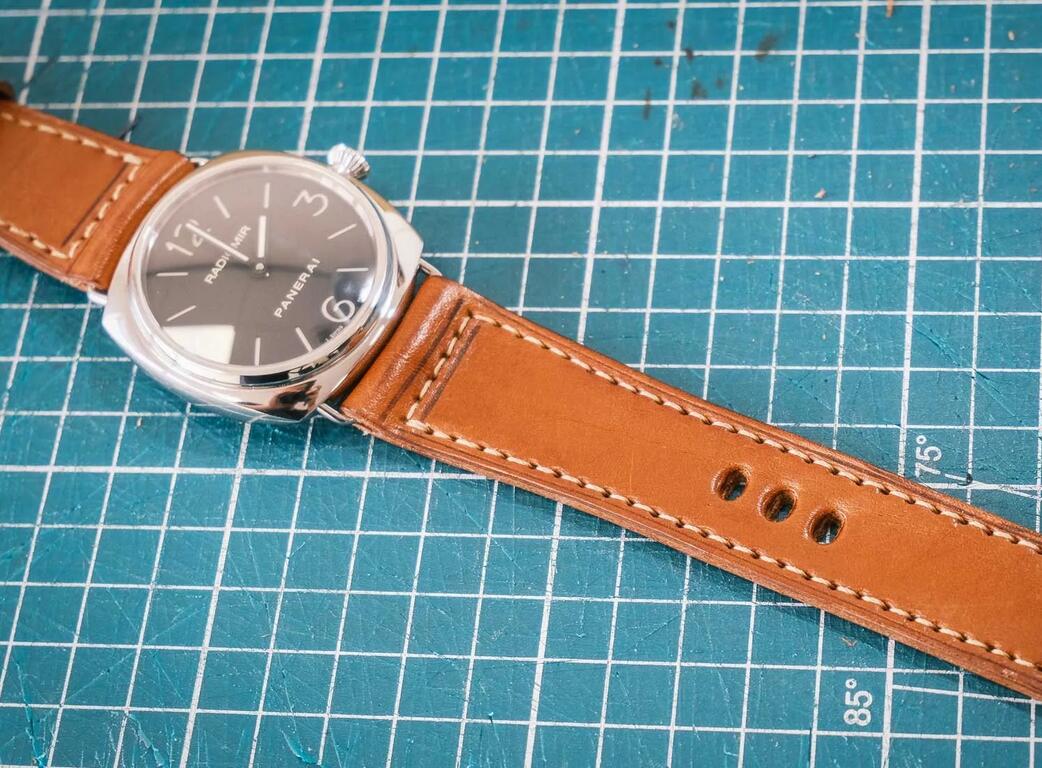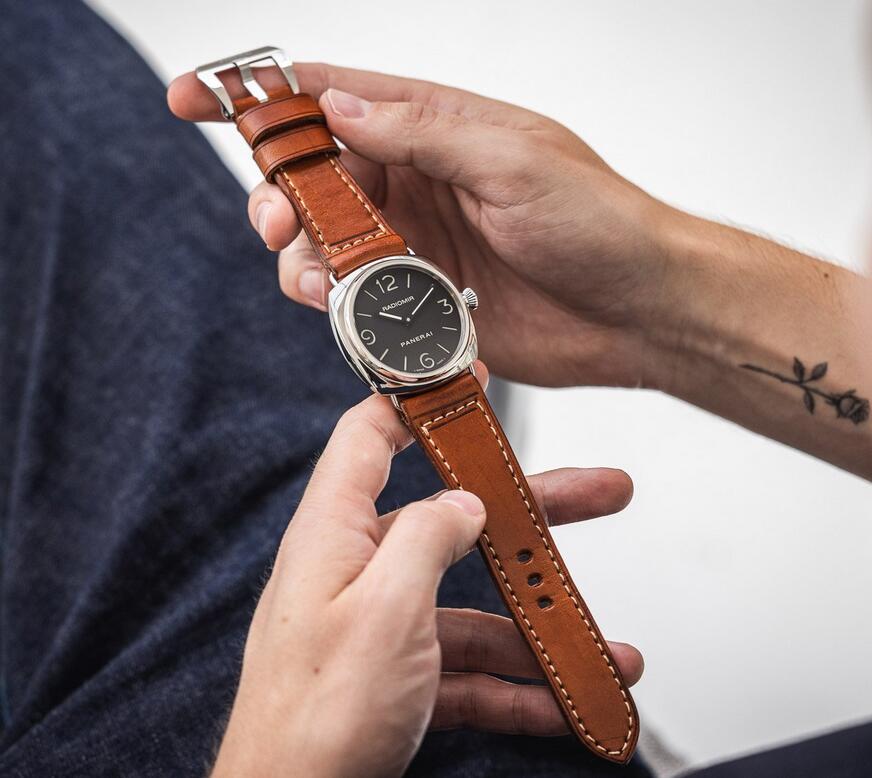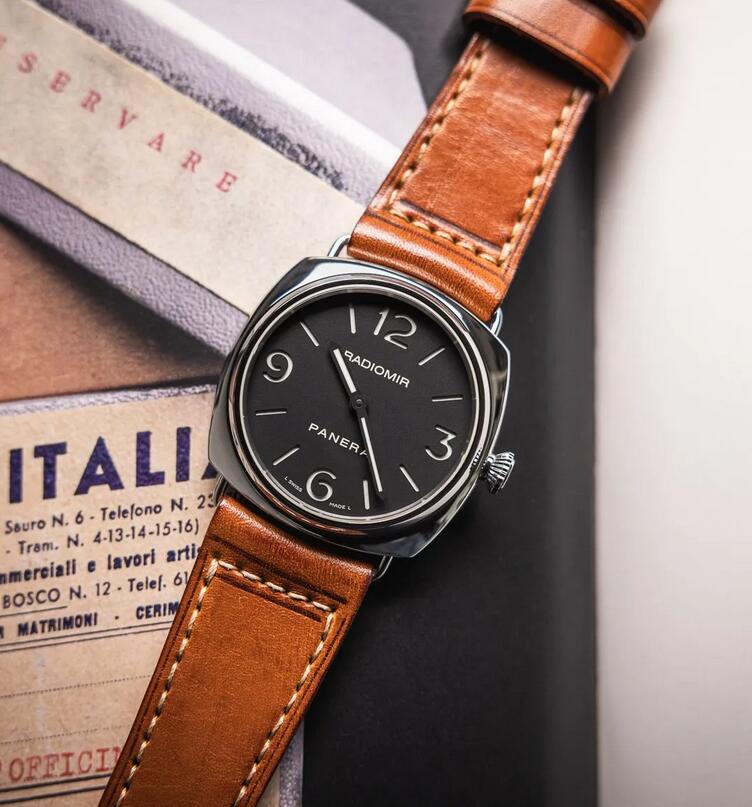If, like me, you have ever found yourself going down the Panerai rabbit hole, you have undoubtedly come across Panerai strap culture. If you haven’t, trust me, it’s a thing! Paneristi are more than typically likely to get something custom made for their prized square possessions. Browsing the internet, you’ll find several aficionados who have acquired leatherworking skills just to make straps for best Panerai replica watches. I figured I should dive in and share with you, Fratelli, what this is all about.
I decided that I would ask my compatriot Olaf Lugten of DStrap to make me a fully custom strap. Although Olaf doesn’t limit himself to straps for UK AAA Panerai fake watches, he is one of the OGs of the genre. As it turns out, he was more than happy to show me how he works. Join me on the journey from a raw cowhide to the most rugged strap I have ever owned.

Speccing my custom watch strap
Of course, the entire idea behind these straps is that they are made to customer spec. Once you lose yourself in the subuniverse of top Panerai super clone watches straps, the possibilities seem endless and quite daunting. So before even reaching out to Olaf, I browsed hundreds of photos on Instagram. The hashtag #paneraistrap (180K posts) leads to tons of custom handmade straps from all over the world. I quickly found myself liking the ones that looked like the original straps on 1930s luxury Panerai Radiomir replica watches online, as seen in the Panerai Museum in Florence.
There are thick, tan leather straps with box or even double-box stitching. They are essentially one piece of leather for each side, folded onto itself and stitched. The inside, then, is the same leather as the outside. Some of the straps feature numbers, which were likely applied when archiving the Swiss movements Panerai copy watches in the museum. I decided I’d prefer the classical style strap but without the numbers.
Now, I could have just ordered a strap like that from stock somewhere online. But I have a pet peeve when it comes to matching different leathers. Since I wear a pair of Red Wing Moc-toes nearly all winter, I wanted a matching strap. So I asked Olaf if he could make me a strap to match my boots. “No problem!” he answered.

Picking the right leather for my custom watch strap
I went to Olaf’s leather workshop in Alkmaar, Netherlands. Olaf loves to make this personal, so we sat down for coffee and a chat for the first hour. Only after the ice was thoroughly broken did we proceed to actual strap-making.
I took one of my boots off, put it on the table, and we started digging through Olaf’s impressive collection of hides. Several approached the color of my boots, including a distinct camel skin. I wasn’t quite sold on the texture, though, as it felt a bit plastic-like. We found a lovely, thick vegetable-tanned piece of cowhide that felt and smelled amazing. It was a bit lighter than my boots, though.
“We can probably fix that!” Olaf said reassuringly. He applied some leather conditioner, which was eagerly soaked up by the open-pored full-grain leather. It turned a few shades darker and suddenly complimented my boots perfectly. “I think we have a winner,” I said. The leather is actually quite similar to what Red Wing uses for the 875 Classic Moc Toe Oro Legacy. With the hide selected, we could get down to business.
Sizing, shaving, and cutting my custom watch strap
Next, Olaf measured my current strap and identified improvement points for the fit. The buckle, for instance, wasn’t quite in the middle of the underside of my wrist, so he compensated for that. I got to decide how far I’d like the pointy end to stick out. And, of course, we took the measurements of the buckle so we could use the original later.
The hide was probably a good 7mm thick, which is way too much. Using an old machine, Olaf started shaving two strips down from the raw (suede or “rough-out”) side. I didn’t want the strap to be too thick since it would stand out on my smallish wrist. We settled on 4mm, meaning the strips had to be shaved down to 2mm.
Next, Olaf folded the strips and cut them to size. The entire shape of the strap is cut by hand using cardboard templates he made over the years. Unhappy with the curve of the pointy end, he decided to start over and redo the longer piece. The straps were folded and glued to allow for precise edge finishing.
Tracing edges and punching holes
At this point, we had the two folded, glued, and shaped pieces of the strap. Olaf punched a rectangular hole for the pin of the buckle. Next, he scored shallow tracks around the edge of the straps with a specific tool. These would be the channels where the stitching would go later on.
Using different punches, Olaf punched holes along the entire edge of the straps. This may sound simple, but it takes a ton of practice to ensure they are all equidistant. At some point, you come full circle, and with everything custom (read: oddly sized), you have to end cleanly.
Next, Olaf traced along the outside of the stitching tracks with a tool similar to a soldering iron. This leaves dark outlines right next to the stitches. I chose to include them on my strap as they are on the original museum straps too. One difference between the originals and mine is the taper. The museum straps are straight, whereas mine tapers from 26mm down to 22mm.
Saddle stitching my custom watch strap
At this point, the strap was ready to be stitched. I chose a thread that was slightly lighter than the leather for a subtle contrast. What happened next took me by surprise, especially since I have a rough idea of how hard it is to do a clean and even saddle stitch.
Olaf took a step back from his workbench and saddle stitched the strap standing up. Having trained as a silversmith myself, I was always told to rest my work and arms on my bench. Olaf just does this in mid-air. Within half an hour or so, he traced the entire box around the strap. “It’s all about the right tightness all around. It took a lot of training to it like this,” he explained.
Next up, he stacked the two half straps and tightly wound a narrower strip of leather around them. Another two holes got punched, and the first keeper was stitched. A second one followed, and one of them got stitched into the buckle side of the strap.

Finishing my custom watch strap
Olaf proceeded to polish the sides of the strap. Naturally, the edge is quite rough as it is basically two stacked suede surfaces. Rubbing beeswax, he filled the last remaining pores for a smooth, closed surface. This not only looks and feels nice, but it will also keep dirt from entering.
All the work around the edges slightly darkened the strap there. We were already quite close to my boots but proceeded to apply the conditioner to make it a perfect match. We anticipated to get in the ballpark, but the result turned out absolutely spot on. Red Wing couldn’t have done a better job, I suspect.
Lastly, we measured the strap on my wrist, with the 1:1 wholesale fake watches attached. Olaf marked where to punch a hole for the perfect fit for me. I decided to put in three holes, so I could adjust either way from my perfect size. Some people have just a single hole punched for the ultimate tailor-made feel. Since my wrist size varies quite a bit, I was more comfortable with an extra hole on either side. And like that, my fully custom watch strap was finished.
Is this the ultimate Panerai experience?
I am over the moon with the result. My Panerai now truly looks like NOS 1930s perfect replica Panerai Radiomir watches. Add to that a perfect fit and a perfect match with my favorite pair of boots. Yes, I have to admit I get this whole Panerai strap culture now. This is a ton of fun!
I am curious to see how the strap will age. My boots tend to get lighter between conditionings. We’ll have to see if the strap does the same and gets the same seasonal treatment. One thing is for sure: this strap is on a different level in terms of ruggedness. This is some of the nicest cowhide around, and at two times 2mm thick, it is quite substantial. The strap is still quite stiff, which will surely change with time. It feels like it needs to be broken in, much like the boots that inspired it. If those boots are anything to go by, the wearing experience will be top-notch after that.
I would like to extend a big “thank you” to Olaf Lugten of DStrap for opening up his workshop for me. Crafting beautiful straps by hand is one thing, but having a big macro lens pointed at your hands while doing it is another. I am confident I will enjoy this strap for years to come. And, judging by pictures of Olaf’s earlier work, it will only get nicer with time.